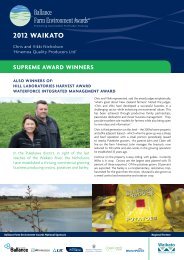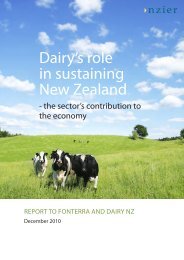NZIER report on compensation for transmission infrastructure
NZIER report on compensation for transmission infrastructure
NZIER report on compensation for transmission infrastructure
Create successful ePaper yourself
Turn your PDF publications into a flip-book with our unique Google optimized e-Paper software.
3. Literature review<br />
In this secti<strong>on</strong> we summarise the most relevant points in the internati<strong>on</strong>al literature <strong>on</strong><br />
easements. The literature review has two main functi<strong>on</strong>s:<br />
To summarise how compensati<strong>on</strong> is calculated and awarded in countries similar<br />
to New Zealand<br />
to identify, based <strong>on</strong> internati<strong>on</strong>al practices, an efficient and equitable approach to<br />
calculating and awarding compensati<strong>on</strong> in New Zealand.<br />
Easements are heavily influenced by nati<strong>on</strong>al or state statutes, enactments and laws,<br />
and we have there<strong>for</strong>e, focused largely <strong>on</strong> countries with similar property rights and<br />
basic legal structure as in New Zealand. Due to the availability of <str<strong>on</strong>g>report</str<strong>on</strong>g>s and<br />
in<strong>for</strong>mati<strong>on</strong> we have included literature from Australia, Canada, the United<br />
Kingdom 12 , parts of Europe and the United States. As well as <str<strong>on</strong>g>report</str<strong>on</strong>g>s and articles the<br />
following is based <strong>on</strong> in<strong>for</strong>mati<strong>on</strong> from utility and landowner representative websites,<br />
and emails from utilities and landowner groups.<br />
Am<strong>on</strong>g the countries we looked at there is, to some extent, a standard set of base<br />
factors used to calculate compensati<strong>on</strong>. How things are d<strong>on</strong>e in practice, however,<br />
appears to vary somewhat between countries and, at times, by utility. Often<br />
compensati<strong>on</strong> details are based <strong>on</strong> legislati<strong>on</strong> and finalised in negotiati<strong>on</strong>s. The often<br />
private nature of negotiati<strong>on</strong>s has limited our ability to include details <strong>on</strong> exactly how<br />
or why outcomes were reached.<br />
3.1 Structure of review<br />
The literature review starts by providing some c<strong>on</strong>text <strong>on</strong> land access rights and the<br />
basis of compensati<strong>on</strong> and then discusses in turn each of the three issues listed<br />
above in the problem definiti<strong>on</strong> (secti<strong>on</strong> 1.3).<br />
Most of the literature focuses <strong>on</strong> how the costs of easements (or wayleaves) are<br />
determined and calculated <strong>for</strong> compensati<strong>on</strong> purposes. As discussed above it is<br />
essential <strong>for</strong> the sake of efficiency to accurately calculate easement costs. Under<br />
efficiency we there<strong>for</strong>e cover:<br />
Equivalence of loss compensati<strong>on</strong><br />
Standard features of compensati<strong>on</strong><br />
area of the easement and land market value<br />
injurious affecti<strong>on</strong><br />
disturbances<br />
12 Utility access to <strong>infrastructure</strong> is often in the <strong>for</strong>m of wayleaves in the United Kingdom, as<br />
opposed to easements in New Zealand and the other countries. The wayleaves literature from<br />
the UK is still relevant, however, <strong>for</strong> much of our discussi<strong>on</strong> <strong>on</strong> compensati<strong>on</strong> <strong>for</strong> transmissi<strong>on</strong><br />
<strong>infrastructure</strong>.<br />
<str<strong>on</strong>g>NZIER</str<strong>on</strong>g> – Compensati<strong>on</strong> <strong>for</strong> transmissi<strong>on</strong> <strong>infrastructure</strong> 17
















